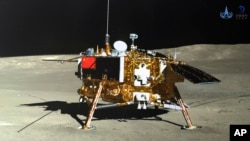China's Chang'e-6 lunar probe looks set to begin its historic journey back to Earth from the moon's far side after collecting samples that scientists expect will help answer key questions about the early evolution of the solar system.
Chang'e-6, named after the mythical Chinese moon goddess, was launched on May 3 from the southern Chinese island province of Hainan.
The fully robotic probe landed on Sunday in a previously unexplored location in a gigantic impact crater called the South-Pole Aitken Basin, on the side of the moon that permanently faces away from Earth.
China's previous Chang'e mission collected samples from the moon's near side in December 2020, restarting global lunar material retrieval efforts after a gap of 44 years.
The uncrewed Luna 24 mission launched by the former Soviet Union in 1976 collected 170.1 grams of samples from Mare Crisium, or "Sea of Crises," on the near side of the moon.
Between 1969 and 1972, six Apollo missions, all crewed, collected 2,200 samples weighing a total of 382 kilograms, also from the side of the moon facing Earth.
James Carpenter, head of the European Space Agency's lunar science office, said the samples collected by the Apollo missions from the moon's near side suggested the South-Pole Aitken Basin on the far side was caused by an epoch of extremely heavy bombardment of the solar system, Earth and moon.
"This is a really core event in the history of the whole solar system, but there is some controversy about whether it happened or not," he said.
"To understand that, you need to anchor those events, and that's going to be done with samples from the lunar far side from the South-Pole Aitken Basin."
Small window
After landing, Chang'e-6 had a 14-hour window to drill, excavate, and seal 2 kg of material, with the goal of being the first probe to bring back such samples from the moon's far side.
This compares to the 21-hour window Chang'e-5 had in 2020. "Once it gets dark, once the sun goes over the horizon, the mission has to end, so there is a limited time window between landing, getting those samples, and getting off the surface again, so it's quite an exciting mission because it has to be done quickly," Carpenter said.
While China said it had improved the efficiency of its digging and drilling machines compared with 2020, the mission could still encounter snags at the sampling phase.
Chang'e-5 returned 1.73 kg of lunar samples, rather than the planned 2 kg, as the drill was only able to create a hole 1 meter deep, rather than 2 meters, after encountering impenetrable layers beneath the surface.
The Chang'e-6 samples will be transferred and sealed on a rocket booster atop the lander, which will launch back into space, dock with another spacecraft in lunar orbit and transfer the samples.
A landing in China's Inner Mongolia is expected around June 25.
Throughout the probe's journey, payloads from Italian, French, and Pakistani research institutes, as well as the European Space Agency, will collect data on questions pertaining to space and the moon, highlighting the growing international weight of China's space program, which is competing with the United States to build a lunar outpost in the next decade.
Carpenter said there was "extremely strong" collaboration between European and Chinese scientists in analyzing the lunar samples brought back by Chang'e-5, and he hoped this would be repeated for Chang'e-6.









